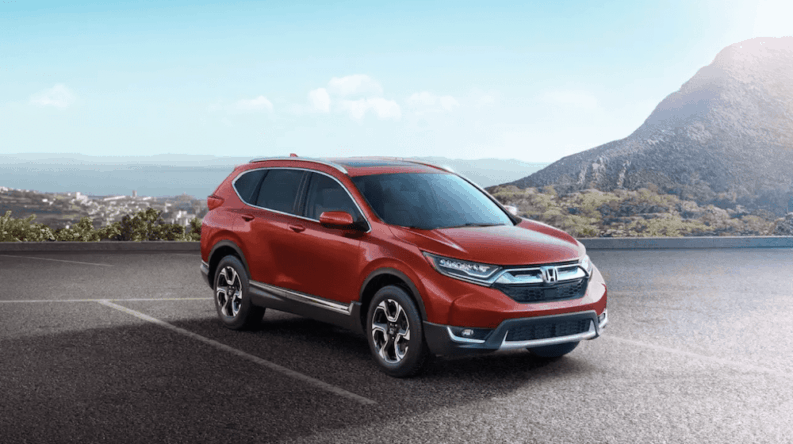As a sports fan, I’ll eagerly include sports analogies even when it might not necessarily be applicable. That probably explains why I decided to compare the 2017 Honda CR-V vs. 2017 Toyota RAV4 by holding an imaginary championship series. I required the two vehicles to duke it out in regards to four specific attributes (or “series”), allowing potential buyers to understand which of the two options may actually be the best choice.
Predictably, it didn’t end up being a particularly competitive series, as the 2017 Honda CR-V managed to pull away thanks to its incredible engines, technological amenities, interior versatility, and safety functions. To see how the two vehicles truly compare, check out our review of the “series” below…
Game 1
In the first game, the 2017 Honda CR-V managed to get some breathing room over the 2017 Toyota RAV4 thanks to the former’s incredible engine offerings. These units have proven to be both powerful and efficient, providing them with a clear advantage over the competitor.
The Honda CR-V came out with its game face on thanks to the standard in-line four-cylinder engine. The system cranks out a respectable 184 horsepower and 180 pounds-feet of torque, which allows the vehicle to overcome adverse road conditions while also beating out fellow drivers on the highway. The engine came up clutch thanks to its ability to deliver an impressive 32-mile-per-gallon highway fuel efficiency.
The lesser-known single-scroll MHI TD03 Turbo and Internal Wastegate made a name for itself during this particular series thanks to its upgraded power. The 190 horsepower and 179 pounds-feet of torque are mighty impressive numbers, especially when you consider the 34-mile-per-gallon highway fuel efficiency.
Meanwhile, the 2017 Toyota RAV4 managed to bring a pair of engines to the plate, but none of the offerings ended up standing up to the capabilities of the CR-V’s engines. The 2.5-Liter 4-Cylinder DOHC 16-Valve engine (with Dual VVT-i) delivers an underwhelming 176 horsepower and 172 pounds-feet of torque, as well as an ordinary 30-mile-per-gallon highway fuel efficiency. Meanwhile, the 2.5-Liter 4-Cylinder DOHC 16-Valve engine (with VVT-i) upgrades the power specs to 194 horsepower, although the lackluster fuel efficiency remains the same.
Game 2
It was an absolute blowout in the second game thanks to the 2017 Honda CR-V’s array of technological offerings. It started with the brand’s 7-inch Display Audio Touch-Screen, which provides access to the Connected Audio system. Meanwhile, thanks to the ability to capitalize on the Apple CarPlay and Android Auto technology, the 2017 Honda CR-V found just another advantage over its rival.
The touchscreen only touched the surface of the 2017 Honda CR-V’s technological offerings. The USB ports included throughout the interior means drivers can constantly keep their preferred gadgets charged. As long as their smartphones have power, this also means they can better access the accompanying HondaLink mobile application.
Finally, the 2017 Honda CR-V ended things early thanks to their Smart Entry system, which provides quick and easy access to your vehicle. Drivers can lock or unlock their doors without taking their keys out of their pocket, thus providing the utmost security.
The Toyota RAV4 didn’t even have a chance during this second game. The Entune Audio Plus provides access to several useful applications, including a Connected Navigation system and a rear-view camera. The Siri Eyes Free technology and the SiriusXM Satellite Radio had solid outings, but they still couldn’t hold a candle to the CR-V’s offerings.
Game 3
The Honda CR-V’s surprising amount of interior room led the vehicle to victory in Game 3. The vehicle delivers a respectable 39.2-cubic-feet of space behind the rear seats, but owners can unlock an incredible 75.8-cubic-feet of space when these seats are hidden. This means owners can truly fit whatever cargo they see fit.
It was the vehicle’s versatility that allowed it to pull away during this third game. The 60/40 Split Rear Fold-Flat Seating allows drivers to adapt their interiors to fit the desired combination of passengers and cargo. The 2017 Honda CR-V made it particularly easy during the later innings, as the Hands Free Tailgate maximizes convenience. By simply waving a foot under the rear bumper, drivers can capitalize on their vehicle’s interior space, even if their hands are full with luggage or groceries. The alternative power tailgate will open with a push of a button, providing similar conveniences.
The 60/40 split folding seats were also featured in the 2017 RAV4, but the underwhelming interior dimensions led to a victory for the CR-V. When all is said and done, drivers can expect 73.4-cubic-feet of space when all of the seats have been hidden, or owners could alternatively opt for the 38.3-cubic-feet of space behind the second row.
Game 4
The 2017 Honda CR-V completed the sweep thanks to its array of safety offerings, led by the brand’s Honda Sensing system. The technology provides drivers with a number of useful safety features that will allow them to avoid accidents altogether, including the Lane Keeping Assist System, Adaptive Cruise Control, Collision Mitigation Braking System, and Road Departure Warning. Some undervalued features also came up big in this deciding game, like the rain-sensing wipers and LED headlights.
The Toyota RAV4’s Star Safety System isn’t nearly as vast as the competing Honda Sensing technology. The vehicle includes capabilities like Vehicle Stability Control, Traction Control, Anti-lock Brake System, Electronic Brake-force Distribution, Brake Assist, and Smart Stop Technology. While there are certainly plenty of options, it’s the lack of innovation that ultimately led to the Toyota RAV4 losing this final game.
Well, it was an absolute blowout in favor of the 2017 Honda CR-V, although this shouldn’t be much of a surprise. Thanks to this hard-hitting analysis, you should now have a better understanding of which compact SUV you should pursue.




